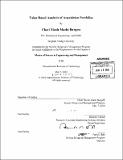| dc.contributor.advisor | Ricardo Valerdi. | en_US |
| dc.contributor.author | Burgess, Cheri Nicole Markt | en_US |
| dc.contributor.other | System Design and Management Program. | en_US |
| dc.date.accessioned | 2010-10-12T18:46:46Z | |
| dc.date.available | 2010-10-12T18:46:46Z | |
| dc.date.copyright | 2010 | en_US |
| dc.date.issued | 2010 | en_US |
| dc.identifier.uri | http://hdl.handle.net/1721.1/59225 | |
| dc.description | Thesis (S.M. in System Design and Management)--Massachusetts Institute of Technology, Engineering Systems Division, 2010. | en_US |
| dc.description | Vita. Cataloged from PDF version of thesis. | en_US |
| dc.description | Includes bibliographical references (p. 113-119). | en_US |
| dc.description.abstract | Currently, program-funding allocation is based on program performance. Funding cuts commonly lead to a poor reflection on the program management assigned to the given program. If additional factors such as program risk and benefit are objectively factored in, this may lead to a more effective exit strategy for program capabilities, which are no longer required. An enterprise architecture analysis and applied framework case study were carried out to develop a methodology to quantify system-level value for the Office of the Assistant Secretary of the Air Force for Acquisition Research, Development, Test and Evaluation portfolio. Portfolio value is quantified in order to transition from a single program, single stakeholder value analysis to a program portfolio and stakeholder system composite analysis. This methodology is developed based on interviews, official organization literature, and a case study. The results of the applied framework case study on a portfolio of seven programs showed a positive correlation between quantitative capability, execution and risk data at the portfolio level and access to a more informed and objective identification of programs of greatest interest and concern as compared to a qualitative program-by-program analysis when allocating Air Force Acquisition resources. This system includes 17 stakeholder categories, which significantly influence the allocation of resources for a portfolio worth roughly 0.4% of the US GDP. Interviews include high-ranking leadership, including two 3-Star Generals in the US Air Force. | en_US |
| dc.description.statementofresponsibility | by Cheri Nicole Markt Burgess. | en_US |
| dc.format.extent | 119 p. | en_US |
| dc.language.iso | eng | en_US |
| dc.publisher | Massachusetts Institute of Technology | en_US |
| dc.rights | M.I.T. theses are protected by
copyright. They may be viewed from this source for any purpose, but
reproduction or distribution in any format is prohibited without written
permission. See provided URL for inquiries about permission. | en_US |
| dc.rights.uri | http://dspace.mit.edu/handle/1721.1/7582 | en_US |
| dc.subject | Engineering Systems Division. | en_US |
| dc.subject | System Design and Management Program. | en_US |
| dc.title | Value based analysis of acquisition portfolios | en_US |
| dc.type | Thesis | en_US |
| dc.description.degree | S.M.in System Design and Management | en_US |
| dc.contributor.department | System Design and Management Program. | en_US |
| dc.contributor.department | Massachusetts Institute of Technology. Engineering Systems Division | |
| dc.identifier.oclc | 666432678 | en_US |
